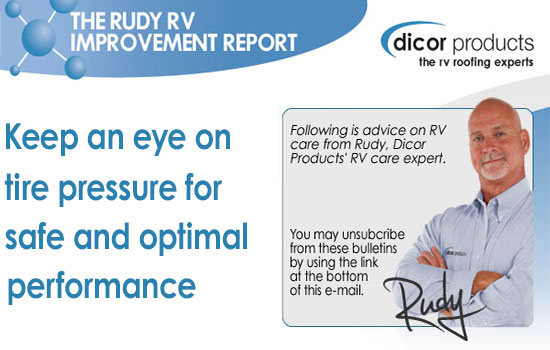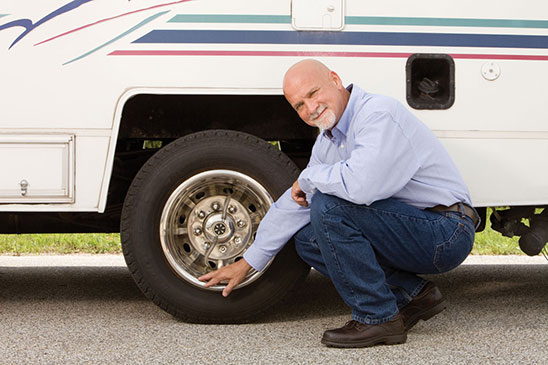

 |
|
In our last report we talked about how balancing the load on each of your tires within the specified axle or wheel weight rating of your RV is important to avoid overstressing the tires, which could lead to potential damage occurring at untimely moments on the road. In this report we want to talk about what you’re doing to your tires and your RVs performance if your tires are underinflated as well as what can happen if your tires are overinflated. The inflation guidelines on the tire wall are there for a reason — a reason well worth noting! 
One tire manufacturer estimates that 40 percent of RVers don't check their tire pressure any more that once every six month. For some, the answer may be that they are thinking more about the first car they drove in high school rather than a modern RV that’s under their control when they glance at their tires and think, "they don’t look low." However, the truth is that with modern radial tires it is virtually impossible to tell by simply looking at the tire to determine if it’s inflated enough, unless it is totally flat. You can only really tell by checking the pressure. As we’ve noted before, Bridgestone/Firestone says a tire can lose 1 to 2 psi a month simply by osmosis, without any discernable leak. If tires become underinflated they will tend to ride on their edges rather than their center, which will actually flex in a bit and lose solid contact with the road. This can yield less traction and, for example, make hydroplaning more likely, as water is better able to get in between the tire and the pavement and cause a temporary loss of control. However, some drivers are actually OK with a bit of underinflation, feeling like it provides a softer ride. This it may do, but at a price. Here are more negative consequences of underinflation:
At the same time, overinflating tires produces similar results from the uneven distribution of weight across the tread:
In addition, both underinflated and overinflated tires make failure from an overloaded RV more likely. Overall, along with safety issues, overinflated and underinflated tires can put an unnecessary hurt on your pocketbook with on-the-road breakdowns, poorer gas mileage and sooner-than-necessary tire replacements. The key to avoiding such problems is maintaining optimal inflation to keep the most rubber firmly on the road by knowing and adhering to the proper pressure through regular and frequent pressure checks. Such maintenance is one of the important components of safe and enjoyable RVing.
Just a reminder: Dicor valve extenders are an inexpensive way of making tire pressure checks easier to do, and thus encourage you to do checks more often. Tire manufacturers recommend pressure checks:
By staying on top of your tire pressure in this way, you will not only ensure that your tires are not overstressed for the weight they’re supporting, but are also giving you maximum fuel efficiency and optimal ride and handling characteristics. For more on RV care and maintenance go to: |
You are receiving this email because you have asked to receieve industry related product and service announcements from Dicor Products. If you would no longer like to receive these emails you may unsubscribe at any time using the link below. |